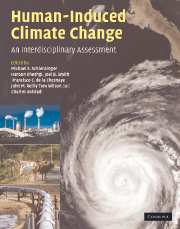Part II - Impacts and adaptation
Published online by Cambridge University Press: 06 December 2010
Summary
Introduction
Estimation of impacts of climate change has long been a challenge for integrated assessment models (IAMs). Uncertainty about regional climate change and how it would translate into impacts is a key reason why it is difficult to estimate impacts of climate change. Yet, perhaps the greatest challenge to characterizing climate change impacts is in applying a single metric to represent impacts. Use of such a single metric allows for a single expression of impacts correlating to emissions or changes in climate. Other key elements of IAMs can be readily expressed in a single metric. Greenhouse gas emissions can be expressed as tonnes of CO2 equivalent. Change in the atmosphere can be expressed through metrics such as radiative forcing (corresponding to the combined forcings of greenhouse gases and aerosols) or increase in global mean temperature. Costs of controlling net greenhouse gas emissions can be expressed in (appropriately) monetary terms.
Boiling the impacts of climate change down to a single metric is challenging for several reasons. First and foremost, many impacts of climate change are not in market sectors, but are on natural ecosystems. Expressing the value of such impacts in monetary terms can be difficult. A key impact of climate change on natural ecosystems is global or regional extinction of species. The value of such species is not typically traded in the market place, so ascribing values can be challenging. Many other impacts of climate change are on societal systems whose values are not entirely captured in market transactions.
- Type
- Chapter
- Information
- Human-Induced Climate ChangeAn Interdisciplinary Assessment, pp. 103 - 106Publisher: Cambridge University PressPrint publication year: 2007
- 1
- Cited by



